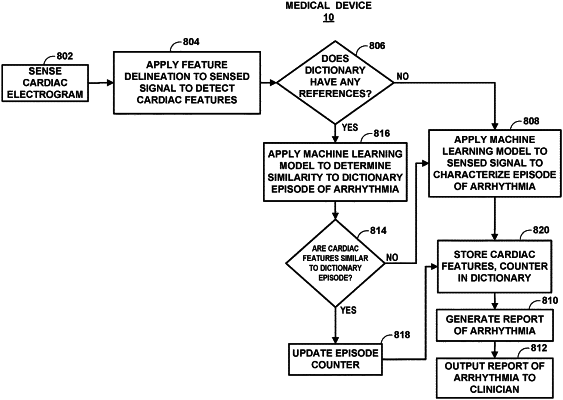| CPC G16H 50/20 (2018.01) [A61B 5/1116 (2013.01); A61B 5/1118 (2013.01); A61B 5/316 (2021.01); A61B 5/35 (2021.01); A61B 5/7264 (2013.01); G06N 5/02 (2013.01); G06N 5/04 (2013.01); G06N 20/00 (2019.01); G16H 50/30 (2018.01)] | 22 Claims |

|
7. A medical device comprising:
a storage medium; and
processing circuitry operably coupled to the storage medium, and configured to:
sense cardiac electrogram data of a patient;
determine that a portion of the cardiac electrogram data is indicative of an arrhythmia, wherein to determine that the portion of the cardiac electrogram data is indicative of the arrhythmia, the processing circuitry is configured to perform feature- based delineation of the sensed cardiac electrogram data to obtain cardiac features present in the cardiac electrogram data and indicative of an episode of arrhythmia in the patient;
in response to determining that the portion of the cardiac electrogram data is indicative of the arrhythmia, determine, based on the feature-based delineation, whether the cardiac features indicative of the episode of arrhythmia satisfy threshold criteria for application of a machine learning model for verifying that the episode of arrhythmia has occurred in the patient;
in response to determining that the cardiac features satisfy the threshold criteria for application of the machine learning model, apply the machine learning model, trained using cardiac electrogram data for a plurality of patients, to the sensed cardiac electrogram data to verify, based on the machine learning model, that the episode of arrhythmia has occurred in the patient; and
in response to verifying, by the machine learning model, that the episode of arrhythmia has occurred in the patient, transmit, to the external device, an indication that the episode of arrhythmia has occurred in the patient and one or more of the cardiac features that coincide with the episode of arrhythmia; and
in response to determining that the cardiac features do not satisfy the threshold criteria for application of the machine learning model, transmit the indication that the episode of the arrhythmia has occurred to the external device without using the machine learning model to verify the that the episode of the arrhythmia has occurred in the patient.
|